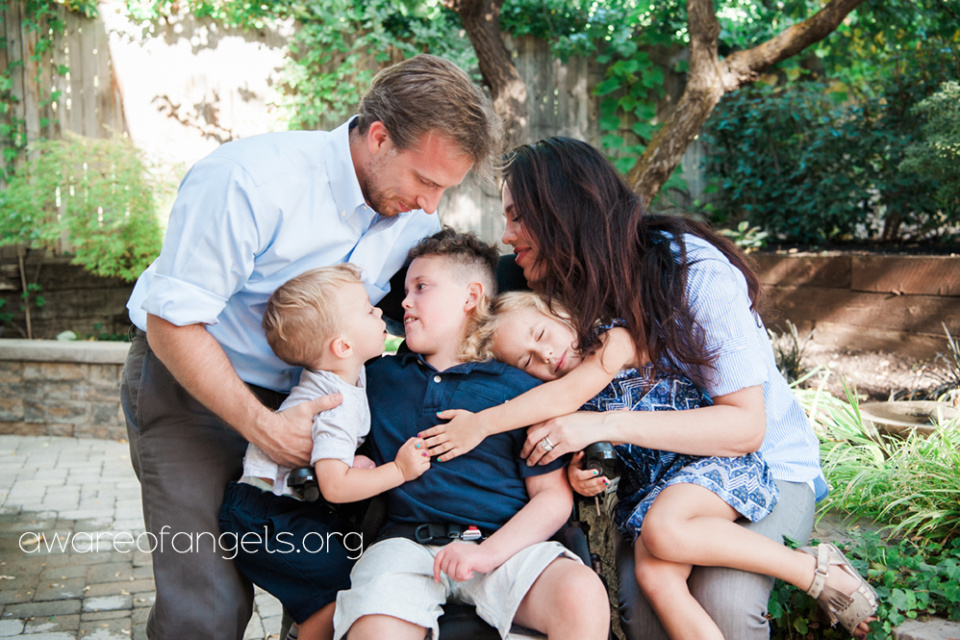Bertrand: 8 years-old
Diagnosis: N-glycanase deficiency
USA
Bertrand was born full-term via natural delivery. His birth weight was a surprising 5 lbs. 12 oz. (an earlier ~36 week ultrasound had hisbirth weight estimated at 8.5 lbs). He suffered from jaundice that did not easily resolve under bililights, resulting in a 5 day NICUstay. At approximately two weeks old, “colic” set in and Bertrand was crying at 1.5 hour intervals around the clock. (Eventually, the colic was partially attributed to acid reflux.) At about this time, we began to see an increase in his moro (startle) reflex. His pediatrician assured us that everything was fine, but Bertrand’s movements seemed increasingly odd to us. He was rolling by 4 months, but did not smileuntil much later. Finally at 6-months, Bertrand was referred to a developmental pediatrician. Despite passing multiple hearing screens, you could ring a bell beside Bertrand’s head and he would not turn to find the sound. His movements were increasingly jerky/jiggly. His developmental pediatrician suspected brain damage from the early jaundice, until an MRI came back clear but his lab results came back showing elevated liver enzyme values (AST, ALT, AFP).
These elevated liver values and the presence of substances called oligosaccharides in his urine, kicked off a 3 year quest to diagnose
Bertrand. Most suspected disorders fell under the heading “errors of cellular metabolism”. In this time Bertrand accumulated an army of
specialists across the US. On top of his developmental delay and movement disorder, additional symptoms were identified, such as peripheral neuropathy, microcephaly, and non-convulsive seizures (staring episodes, falling, small jerks). Everywhere we went, we asked doctors about Bertrand’s lack of tears, but no one could give us an answer or seemed to think it was significant.
On top of his developmental delay and movement disorder, additional symptoms were identified, such as peripheral neuropathy, microcephaly, and non-convulsive seizures (staring episodes, falling, small jerks). Everywhere we went, we asked doctors about Bertrand’s lack of tears, but no one could give us an answer or seemed to think it was significant.
Finally, thanks to an excellent team of researchers at Duke University, Bertrand was diagnosed via whole exome sequencing as the
first case of N-glycanase (NGLY1) deficiency. N-glycanase deficiency falls in the family of Congenital Disorders of Glycosylation (CDG).
Two years after the initial publication describing Bertrand’s condition, there are 55 known cases worldwide.
Characteristics of N-glycanase (NGLY1) deficiency include but are not
limited to:
Lack of tears (alacrima/hypolacrima)
Developmental delay
Movement disorder
Elevated liver enzymes
While there is no cure for NGLY1, and several children have passed away from the condition, there are a number of treatments that improve patient quality of life by addressing mitochondrial dysfunction (N-acetyl cysteine, coenzyme Q10, etc.). There is also hope for an
impending pharmaceutical clinical trial.
Bertrand is developmentally ~9 months-old. He cannot feed himself, ambulate, use the restroom, or speak. Bertrand is in a life skills
classroom. He needs daily physical, occupational, and speech therapy. Bertrand is exceptionally happy and good natured. He loves Elmo,
books, water, and playing with his younger sister Victoria and brother Winston.
In the face of many challenges, Bertrand continues to teach and inspire everyone around him—his parents most of all. We couldn’t be
more proud or happy to call him our son.
To contact us: bertrand@might.net
For more on Bertrand: http://www.
For more on N-glycanase deficiency: http://www.ngly1.org

